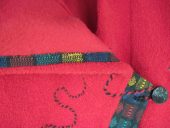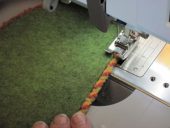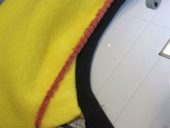Rochelle’s Reversibles Workshop
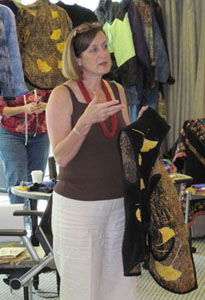 Rochelle Harper spoke at the Columbia River Sewing ASG September meeting held in Hillsboro on September 19, 2009. Author of Sewing Outdoor Gear – Easy Techniques for Outerwear That Works, she discussed many of the more important points presented in her book.
Rochelle Harper spoke at the Columbia River Sewing ASG September meeting held in Hillsboro on September 19, 2009. Author of Sewing Outdoor Gear – Easy Techniques for Outerwear That Works, she discussed many of the more important points presented in her book.
Rochelle began her program with a little exercise in fabric identification. She passed around several samples of fabric and asked us to describe the properties of the samples. As a group we were quite knowledgeable about fabrics.
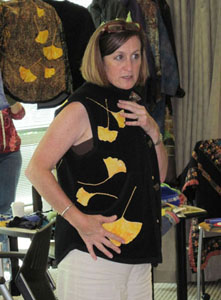 Next she described how test a fabric for breathability. Hold near your face and blow on/through it. Note how the fabric responds—do you feel it come out the other side?
Next she described how test a fabric for breathability. Hold near your face and blow on/through it. Note how the fabric responds—do you feel it come out the other side?
We learned the importance of properly identifying the right side of any fleece, waterproof, breathable or wicking fabric. Sewn wrong side out, water will to the body. Along the selvage, fleece curls to RIGHT side; along the cross grain, fleece curls to wrong side.
Quality fleece which does not pill or get matted like the inexpensive fleece that is often available at large chain fabric stores. Rochelle considers Malden Mills fleece to be the best and demonstrate the difference in quality, by showing several jackets made from the Malden Mills fleece, worn constantly by her daughters for many years, but still looking nice. To compare, she pulled out a hat made of quality fleece with a decorative strip of inexpensive fleece, where he latter was matted and worn while the rest of the hat was fine. I quickly hid my JoAnn’s Fleece under the table and resolved to go to Rose City Textiles and purchase some nice fleece.
Rochelle recommends that fleece garments be washed inside out in a mild soap like Ivory or Orvis (available in quilt and feed stores) and dried on a warm setting to re-establish the water repellency.

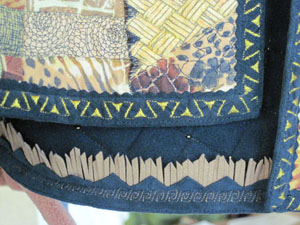 Among the techniques learned were creating coordinated twisted cord trim, best ways to apply binding, and using a burning tool to create synthetic fabric appliques.
Among the techniques learned were creating coordinated twisted cord trim, best ways to apply binding, and using a burning tool to create synthetic fabric appliques.
Twisted cording can be used as trim around pockets or couched directly onto fabric. Made from narrow strips of fleece, stretched and twisted together, the cording takes advantage of the great amount of stretch that fleece has from selvage to selvage.
Finish the edges of fleece on jackets with nylon lycra or a narrow strip of microfleece binding, cut from coordinating fabric. Attach using an edge-stitching foot, using a longer stitch length and stretching the binding slightly as you sew.
 Using a “Hot Tool” with a stencil tip, Rochelle demonstrated how to make appliqués out of nylon. The hot tool also can be used to prevent raveling on nylon and other synthetic materials when making garments. However, because the edges can be scratchy, she recommended using either flat-felled seams or a Hong-Kong finish on garments worn next to the skin.
Using a “Hot Tool” with a stencil tip, Rochelle demonstrated how to make appliqués out of nylon. The hot tool also can be used to prevent raveling on nylon and other synthetic materials when making garments. However, because the edges can be scratchy, she recommended using either flat-felled seams or a Hong-Kong finish on garments worn next to the skin.
Rochelle’s samples were stunning, and everyone left with lots of embellishment ideas and inspiration. Thank you Rochelle for a fun and inspiring day!
Andie Letourneau and Cynthia Scott


